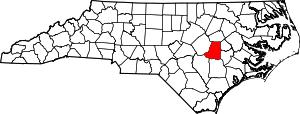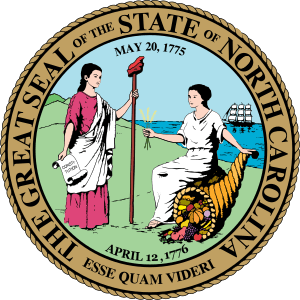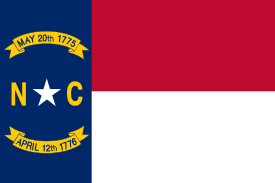Wayne County, North Carolina
Wayne County is a county located in the U.S. state of North Carolina. As of the 2010 Census, the population was 122,623.[1] Its county seat is Goldsboro[2] and it is home to Seymour Johnson Air Force Base.
Wayne County | |
|---|---|
 Wayne County Courthouse in Goldsboro, 1948 | |
 Seal | |
 Location within the U.S. state of North Carolina | |
 North Carolina's location within the U.S. | |
| Coordinates: 35°22′N 78°00′W | |
| Country | |
| State | |
| Founded | 1779 |
| Named for | Anthony Wayne |
| Seat | Goldsboro |
| Largest city | Goldsboro |
| Area | |
| • Total | 557 sq mi (1,440 km2) |
| • Land | 553 sq mi (1,430 km2) |
| • Water | 3.8 sq mi (10 km2) 0.7%% |
| Population | |
| • Estimate (2019) | 123,131 |
| • Density | 222/sq mi (86/km2) |
| Time zone | UTC−5 (Eastern) |
| • Summer (DST) | UTC−4 (EDT) |
| Congressional district | 7th |
| Website | www |
Wayne County comprises the Goldsboro, NC Metropolitan Statistical Area.
History
Prior to 1730, Native Americans were the only known occupants of the territory now known as Wayne County. Settlers trickled into the territory, occupying land along the Neuse River. There was no general migration here until after 1750; as populations built up in the coastal areas, some settlers moved west for land.[3]
Wayne County was established during the American Revolutionary War on November 2, 1779 from the western part of Dobbs County. It was named for "Mad Anthony" Wayne, a general in the war. The act establishing the County provided that the first court should be held at the home of Josiah Sasser, at which time the justices were to decide on a place for all subsequent courts until a courthouse could be erected. By 1782 the commissioners were named. In 1787 an act was passed establishing Waynesborough on the west side of the Neuse River, on the land of Doctor Andrew Bass. The courthouse was built here.[4]
In 1855 parts of Wayne County, Edgecombe County, Johnston County, and Nash County were combined to form Wilson County.
Geography
According to the U.S. Census Bureau, the county has a total area of 557 square miles (1,440 km2), of which 553 square miles (1,430 km2) is land and 3.8 square miles (9.8 km2) (0.7%) is water.[5]
Wayne County's surface is level to gently rolling uplands with broad bottoms along the rivers and some creeks. Elevations are predominantly 120 to 145 feet above sea level. The largest waterway, the Neuse River, bisects the lower central portion of the county and cuts a deep channel 20 to 40 feet deep as it flows in an eastward direction. Unusual river bluffs occur in the vicinity of Seven Springs. In addition to the Neuse River, the county is drained by the Little River, the Northeast Cape Fear River and numerous creeks.
Wayne County is underlain by unconsolidated beds of sand, clay and gravel. For the most part, these beds were deposited in seawater as the sea advanced and retreated during the geologic development of the Atlantic Coastal Plain. To a much lesser extent, streams deposited layers of sediment which mixed with that deposited on the sea floor.
The climate in Wayne County is characterized by warm summers and moderate winters. The average temperature is about 62 degrees. Annual precipitation is about 50 inches of rainfall per year, with the major portion occurring in the late spring and summer.[4]
Adjacent counties
- Wilson County - north
- Greene County - east-northeast
- Lenoir County - east-southeast
- Duplin County - south
- Sampson County - southwest
- Johnston County - west
Demographics
| Historical population | |||
|---|---|---|---|
| Census | Pop. | %± | |
| 1790 | 6,115 | — | |
| 1800 | 6,772 | 10.7% | |
| 1810 | 8,687 | 28.3% | |
| 1820 | 9,040 | 4.1% | |
| 1830 | 10,331 | 14.3% | |
| 1840 | 10,891 | 5.4% | |
| 1850 | 13,486 | 23.8% | |
| 1860 | 14,905 | 10.5% | |
| 1870 | 18,144 | 21.7% | |
| 1880 | 24,951 | 37.5% | |
| 1890 | 26,100 | 4.6% | |
| 1900 | 31,356 | 20.1% | |
| 1910 | 35,698 | 13.8% | |
| 1920 | 43,640 | 22.2% | |
| 1930 | 53,013 | 21.5% | |
| 1940 | 58,328 | 10.0% | |
| 1950 | 64,267 | 10.2% | |
| 1960 | 82,059 | 27.7% | |
| 1970 | 85,408 | 4.1% | |
| 1980 | 97,054 | 13.6% | |
| 1990 | 104,666 | 7.8% | |
| 2000 | 113,329 | 8.3% | |
| 2010 | 122,623 | 8.2% | |
| Est. 2019 | 123,131 | [6] | 0.4% |
| U.S. Decennial Census[7] 1790-1960[8] 1900-1990[9] 1990-2000[10] 2010-2019[1] | |||
As of the census[11] of 2000, there were 113,329 people, 42,612 households, and 30,254 families residing in the county. The population density was 205 people per square mile (79/km²). There were 47,313 housing units at an average density of 86 per square mile (33/km²). The racial makeup of the county was 61.28% White, 33.02% Black or African American, 0.36% Native American, 0.96% Asian, 0.05% Pacific Islander, 3.07% from other races, and 1.25% from two or more races. 4.94% of the population were Hispanic or Latino of any race.
There were 42,612 households out of which 34.70% had children under the age of 18 living with them, 51.60% were married couples living together, 15.40% had a female householder with no husband present, and 29.00% were non-families. 24.50% of all households were made up of individuals and 9.00% had someone living alone who was 65 years of age or older. The average household size was 2.55 and the average family size was 3.03.
In the county, the population was spread out with 26.20% under the age of 18, 9.90% from 18 to 24, 30.50% from 25 to 44, 21.90% from 45 to 64, and 11.60% who were 65 years of age or older. The median age was 35 years. For every 100 females there were 97.30 males. For every 100 females age 18 and over, there were 94.30 males.
The median income for a household in the county was $33,942, and the median income for a family was $40,492. Males had a median income of $28,396 versus $21,854 for females. The per capita income for the county was $17,010. About 10.20% of families and 13.80% of the population were below the poverty line, including 18.60% of those under age 18 and 15.20% of those age 65 or over.
Communities
City
- Goldsboro (county seat)
Towns
- Eureka
- Fremont
- Mount Olive
- Seven Springs
- Pikeville
Villages
Townships
- Brogden
- Buck Swamp
- Fork
- Goldsboro
- Grantham
- Hood Swamp
- Indian Springs
- Nahunta
- New Hope
- Pikeville
- Saulston
- Stoney Creek
Economy
Wayne County's local industries are involved in a range of operations from simple assembly to complex manufacturing processes resulting in products ranging from bread and poultry feed to automobile parts and electric transformers. Substantial technological improvements in recent years involving modernization of plant facilities and the addition of sophisticated manufacturing equipment have resulted in enhanced profitability and productivity for many of the local manufacturing firms.
The combination of a mild climate, a freeze-free growing season of about 225 days and a wide range of soil types contribute to a highly productive agricultural area. Total gross farm sales in Wayne County in 2006 was approximately $329,082,138 USD. Field crops, including the primary crops of tobacco, corn, cotton, soybeans, and wheat accounted for nearly 12% of the farm income or $38,583,389USD.
Income from livestock and poultry production was $236,287,547USD in 2006 and derived primarily from swine operations. Swine production has increased rapidly, making it the single largest source of farm income. In 2006 farm income from swine production was $75,409,690USD or 23% of all farm income. Wayne County ranks 7th in the nation for production of swine.[12]
Seymour Johnson Air Force Base is home to the 4th Fighter Wing and 916th Air Refueling Wing. The annual civilian and military payroll is over $282 millionUSD. In fiscal year 2006 the economic impact at the base totaled over $460 millionUSD.[4]
Politics, law and government
Wayne was historically a typical "Solid South" county for the first two thirds of the twentieth century, as conservative white Democrats had passed a new constitution at the turn of the 20th century that disenfranchised most blacks. North Carolina became a virtually one-party state, with whites generally voting for Democratic Party Candidates. In 1928, opposition to Roman Catholic candidate Al Smith resulted in these voters supporting Republican (and Protestant) Herbert Hoover for president.
Following Congressional passage of major civil rights legislation in the mid-1960s, this county's white voters, like most across the South, gradually started to support Republican national candidates and ultimately changed parties, joining the Republicans. But in 1968, they voted for segregationist "American Independent" George Wallace. Since 1972, the white majority of Wayne County has carried it for Republican presidential candidates in every election. Since 2008, when President Barack Obama was elected, the Democratic Party has become more competitive and Republican victory margins have declined.
| Year | Republican | Democratic | Third parties |
|---|---|---|---|
| 2016 | 54.3% 27,540 | 43.0% 21,770 | 2.7% 1,379 |
| 2012 | 53.8% 27,641 | 45.4% 23,314 | 0.8% 397 |
| 2008 | 54.0% 26,952 | 45.5% 22,671 | 0.5% 259 |
| 2004 | 62.1% 24,883 | 37.7% 15,076 | 0.2% 87 |
| 2000 | 61.3% 20,758 | 38.4% 13,005 | 0.4% 121 |
| 1996 | 56.4% 16,588 | 39.4% 11,580 | 4.2% 1,222 |
| 1992 | 52.3% 14,397 | 37.4% 10,307 | 10.3% 2,828 |
| 1988 | 62.5% 15,292 | 37.3% 9,135 | 0.2% 47 |
| 1984 | 64.1% 17,961 | 35.7% 10,011 | 0.1% 36 |
| 1980 | 56.3% 12,860 | 42.0% 9,586 | 1.7% 390 |
| 1976 | 50.6% 9,607 | 48.8% 9,265 | 0.6% 121 |
| 1972 | 72.3% 14,352 | 26.4% 5,234 | 1.3% 256 |
| 1968 | 28.8% 5,678 | 27.1% 5,338 | 44.2% 8,709 |
| 1964 | 43.6% 7,555 | 56.5% 9,791 | |
| 1960 | 41.1% 5,474 | 58.9% 7,856 | |
| 1956 | 38.5% 4,220 | 61.6% 6,756 | |
| 1952 | 39.0% 4,662 | 61.0% 7,281 | |
| 1948 | 19.9% 1,658 | 73.2% 6,111 | 6.9% 579 |
| 1944 | 23.5% 1,914 | 76.5% 6,228 | |
| 1940 | 18.6% 1,649 | 81.4% 7,222 | |
| 1936 | 19.8% 1,751 | 80.2% 7,087 | |
| 1932 | 20.3% 1,631 | 79.0% 6,365 | 0.7% 60 |
| 1928 | 53.9% 4,340 | 46.2% 3,720 | |
| 1924 | 28.8% 1,379 | 70.3% 3,366 | 0.9% 42 |
| 1920 | 37.1% 2,822 | 63.0% 4,794 | |
| 1916 | 35.5% 1,446 | 64.4% 2,625 | 0.1% 5 |
| 1912 | 2.7% 95 | 65.5% 2,293 | 31.8% 1,115 |
Wayne County is governed by a commissioner-manager system, consisting of seven members elected to four-year terms. One commissioner is elected from each of six single-member districts in the county and one is elected at-large countywide. All seven members serve concurrent four-year terms. The partisan elections for the Board of Commissioners are held in November in even-numbered years. The Board elects a Chairman and Vice-Chairman from among its members annually at the first meeting in December.[4] The Board meets on the first and third Tuesday each month.
Wayne County is a member of the regional Eastern Carolina Council of Governments.
Education
Wayne County is home to three colleges: Wayne Community College, University of Mount Olive (formerly known as Mount Olive College), and the Goldsboro campus of the North Carolina Wesleyan College.
Public schools are administered by the Wayne County Public Schools system. The public schools include nine high schools and college preparation schools, nine middle schools, fourteen elementary schools and one special education school. The county is also home to one charter public school and six private schools.
High schools
Middle schools
- Brogden Middle School
- Dillard Middle School
- Eastern Wayne Middle School
- Grantham Middle School
- Greenwood Middle School
- Mount Olive Middle School
- Norwayne Middle School
- Rosewood Middle School
- Spring Creek Middle School
Elementary schools
- Brogden Primary School
- Carver Elementary School
- Carver Heights Elementary School
- Eastern Wayne Elementary School
- Fremont Stars Elementary School
- Grantham Elementary School
- Meadow Lane Elementary School
- North Drive Elementary School
- Northeast Elementary School
- Northwest Elementary School
- Rosewood Elementary School
- School Street Early Learning Center
- Spring Creek Elementary School
- Tommy's Road Elementary School
Special Education Schools
- Edgewood Community Developmental School
Private schools
- Faith Christian Academy
- Pathway Christian Academy
- Wayne Christian School
- Wayne Country Day School
- St. Mary Catholic School
- Wayne Preparatory Academy
Hospitals
- Wayne Memorial Hospital (North Carolina), a medical facility located in Goldsboro, is the county's second-largest employer.
- Cherry Hospital is a psychiatric hospital located in Goldsboro; it was founded in 1880 as a facility to treat mentally ill African Americans when all public facilities were segregated. A museum depicting its history is part of the hospital campus.
- O'Berry Neuro-Medical Center is a North Carolina Department of Health and Human Services hospital providing rehabilitative services to the mentally retarded and people with developmental disabilities.
Transportation
Passenger
- Air: Wayne County is served through nearby Kinston Regional Jetport (IATA: ISO, ICAO: KISO) with service to Orlando, Florida. Raleigh-Durham International Airport is the closest major airport with service to more than 45 domestic and international destinations. Wayne Executive Jetport is an airport located in Wayne County, but is only used for general aviation.
- Interstate Highway: Interstate 795 (I-795) links Goldsboro to Interstate 95 near Wilson, NC in Wilson County.
- Wayne County is not served directly by passenger trains. The closest Amtrak station is located in Selma, NC.
- Bus: The county is served by Greyhound with a location in Goldsboro.
Roads
- The main highway in Wayne County is US 70, which offers access to the North Carolina coast, the capital city of Raleigh and I-95. The only interstate in Wayne County is I-795, which is a direct connector with I-95 and US 264. US 70 has been designated as Future Interstate 42.[14][15]
- Other highways that run through the county include US 13, US 117, and NC 111, NC 222, and NC 581.
Media
- The Goldsboro News-Argus
- Goldsboro Daily News
- The Buzz Around Wayne County
- Mount Olive Tribune
- Wayne-Wilson News Leader
- WGBR 98.3 FM / 1150 AM -- Classic Hits
- WFMC 105.7 FM / 730 AM -- Gospel
- WZKT 97.7 FM -- Katie Country
- WSSG 92.7 FM / 1300 AM - Hip Hop & R&B
Notable residents
- Ike Atkinson, drug trafficker
- Charles Brantley Aycock, politician
- Bob Boyd, golfer
- Moira Crone, author
- Ava Gardner, actress
- Anne Jeffreys, actress
- Carl Kasell, radio personality
- Manny Lawson, American football linebacker
- Jerry Narron, MLB player, coach, manager
- Tony Schiffman, jeweller
- John R. Smith, politician
- Michale Spicer, American football defensive end
- Greg Warren, American football long snapper
- James B. Whitfield, lawyer
- Cadmus M. Wilcox, Confederate general
See also
- List of North Carolina counties
- National Register of Historic Places listings in Wayne County, North Carolina
References
- "State & County QuickFacts". United States Census Bureau. Retrieved October 30, 2013.
- "Find a County". National Association of Counties. Retrieved 2011-06-07.
- Wayne County Heritage Book Committee (1982). "The Heritage of Wayne County, North Carolina". pp. 137, 232, 530.
- Wayne County Facts Archived 2008-07-24 at the Wayback Machine
- "2010 Census Gazetteer Files". United States Census Bureau. August 22, 2012. Archived from the original on January 12, 2015. Retrieved January 20, 2015.
- "Population and Housing Unit Estimates". Retrieved May 21, 2020.
- "U.S. Decennial Census". United States Census Bureau. Retrieved January 20, 2015.
- "Historical Census Browser". University of Virginia Library. Retrieved January 20, 2015.
- Forstall, Richard L., ed. (March 27, 1995). "Population of Counties by Decennial Census: 1900 to 1990". United States Census Bureau. Retrieved January 20, 2015.
- "Census 2000 PHC-T-4. Ranking Tables for Counties: 1990 and 2000" (PDF). United States Census Bureau. April 2, 2001. Retrieved January 20, 2015.
- "U.S. Census website". United States Census Bureau. Retrieved 2008-01-31.
- Wayne County, North Carolina NC, county profile - hotels, festivals, genealogy, newspapers - ePodunk
- Leip, David. "Dave Leip's Atlas of U.S. Presidential Elections". uselectionatlas.org. Retrieved 2018-03-17.
- "North Carolina Gains Names for Two New Interstate Designations" (Press release). Raleigh, NC: North Carolina Department of Transportation. May 25, 2016. Retrieved May 25, 2016.
- Special Committee on U.S. Route Numbering (May 24, 2016). "Special Committee on U.S. Route Numbering" (PDF) (Report). Washington, DC: American Association of State Highway and Transportation Officials. p. 7. Archived (PDF) from the original on December 16, 2017. Retrieved May 26, 2016.

